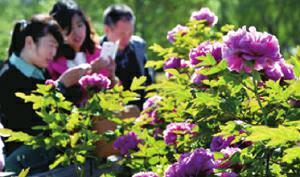Flower Power
2015-11-05ByAaronAnthonyVes
By+Aaron+Anthony+Vessup
Can you imagine a world without colorful flowers? I, for one, cannot. Clearly, all cultures delight in the visual presence and aromas of natures garden plants. In most Chinese cities, great pains are taken to plant and arrange colorful floral displays at city gates, major street intersections, and along highways.
Flowers are at every ceremony and pageant in China. In fact, it seems that something beyond tradition and the notions of romantic bouquets or aesthetic decoration compels the Chinese to continually bring natures colors inside their living quarters.
So prettiness aside, what place do flowers have in our national mythologies and what can this tell us about their practical applications? On a recent trip outside of China—traveling down the west coast of Costa Rica, not far from San Jose—I came into contact with a yellow bellshaped flower almost the size of a human head. These hornlike fluted flowers are called Las Reyes de Noches, literally meaning “the Queens of the Night” in Spanish. It is said to have magical properties with respect to erotic stimulation. According to folklore, one merely place this flower on or beneath ones sleeping bed, and wondrous things are guaranteed to happen between two people.
Back in China, I asked several of my Chinese friends if there was a flower on the mainland with an accompanying reputation or story of any kind. Specifically, I wished to glean new information on topics lying beyond the traditional allure of red roses or chrysanthemums. The responses were wide and varied. Eventually, I was directed to the labahua, also known as the“trumpet flower.” It is a small flute-like flower, and comes in white, lavender, and a combination of red and white. According to scientific research, this flower has medicinal properties that can effectively be employed in treating the swelling nephritis by reducing hot internal humidity.
The ancient city Luoyang in central Chinas Henan Province has a reputation as a cultivation center for peonies. Throughout Chinese history, peonies in Luoyang have been said to be the finest in the country. Dozens of peony exhibitions and shows are still held there annually. The peony is among the longest-used flowers in Eastern culture and is a traditional floral symbol of China. It is also known as “flower of riches and honor” or “king of the flowers.”
In Japan, moreover, the root of the peony has been known to help treat convulsions. Mischievous nymphs were said to hide in the petals of the flowers, leading to the flower becoming synonymous with shame or bashfulness during the Victorian era. In China, the fallen petals of peonies are parboiled and sweetened to serve as a tea-time delicacy. Peony water was used for drinking in the Middle Ages. The petals are often added to salads, punches, and lemonades.
